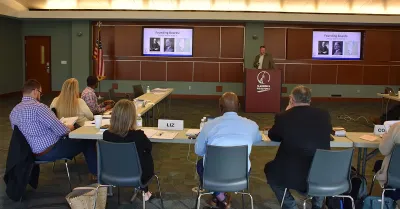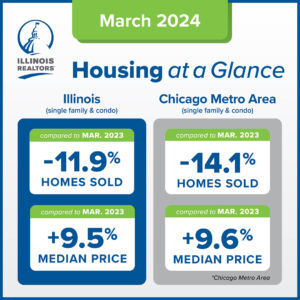The factors that played a major role in the Illinois housing market in 2017 – shrinking inventory, homes selling quickly and ongoing median price gains – are expected to continue in 2018, Geoffrey J.D. Hewings, director of the Regional Economics Applications Laboratory (REAL) at the University of Illinois, said today during a presentation at the Illinois REALTORS® Public Policy Meetings in East Peoria.
Hewings’ annual presentation to REALTORS® offers insight into the Illinois housing market and the state economic trends impacting it.
Some takeaways from Hewings’ presentation (The Powerpoint slides are here):
Illinois’ Population Falls to 6th Place – Capping off four years of steady population declines, the state in 2017 dropped to 6th place in terms of state populations. Out-migration is an issue and more than 33,000 people left Illinois just last year, Hewings said. When in-migration doesn’t replace those losses, it impacts the housing market.
Slow Job Growth – At the same time, Illinois job growth lags behind the U.S. and other Midwest states. Illinois added only 25,900 jobs in the last 12 months, far behind the 83,000 jobs needed to grow at the rate of its share of the gross domestic product, he said. Illinois has the skilled workers to attract companies and jobs, but the state’s political infighting often gets in the way, Hewings said. REALTORS® can be a voice reminding political leaders that bipartisan efforts to improve the economy will help the housing market.
Immigration – Illinois’ population is graying and without an influx of immigrants in the future, the state’s future economic growth will slow, Hewings said. It is estimated that by 2030, 20 percent of Illinois’ population will 65 or older. As that shift happens, the state will need more young, talented people in the workforce.
Federal Tax Reform – It is still too early to know exactly how the new federal tax changes will affect the housing market, Hewings said. Consumers don’t always register how incremental tax cuts affect their personal bottom line and it isn’t known yet how consumers will react to changes regarding state and local taxes, Hewings said.




 Create professional development programs that help REALTORS® strengthen their businesses.
Create professional development programs that help REALTORS® strengthen their businesses.
 Protect private property rights and promote the value of REALTORS®.
Protect private property rights and promote the value of REALTORS®.
 Advance ethics enforcement programs that increase REALTOR® professionalism.
Advance ethics enforcement programs that increase REALTOR® professionalism.
 Protect REALTORS® by providing legal guidance and education.
Protect REALTORS® by providing legal guidance and education. Stay current on industry issues with daily news from Illinois REALTORS®, network with other professionals, attend a seminar, and keep up with industry trends through events throughout the year.
Stay current on industry issues with daily news from Illinois REALTORS®, network with other professionals, attend a seminar, and keep up with industry trends through events throughout the year.







